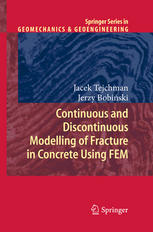

Most ebook files are in PDF format, so you can easily read them using various software such as Foxit Reader or directly on the Google Chrome browser.
Some ebook files are released by publishers in other formats such as .awz, .mobi, .epub, .fb2, etc. You may need to install specific software to read these formats on mobile/PC, such as Calibre.
Please read the tutorial at this link: https://ebookbell.com/faq
We offer FREE conversion to the popular formats you request; however, this may take some time. Therefore, right after payment, please email us, and we will try to provide the service as quickly as possible.
For some exceptional file formats or broken links (if any), please refrain from opening any disputes. Instead, email us first, and we will try to assist within a maximum of 6 hours.
EbookBell Team

0.0
0 reviewsThe book analyzes a quasi-static fracture process in concrete and reinforced concrete by means of constitutive models formulated within continuum mechanics. A continuous and discontinuous modelling approach was used. Using a continuous approach, numerical analyses were performed using a finite element method and four different enhanced continuum models: isotropic elasto-plastic, isotropic damage and anisotropic smeared crack one. The models were equipped with a characteristic length of micro-structure by means of a non-local and a second-gradient theory. So they could properly describe the formation of localized zones with a certain thickness and spacing and a related deterministic size effect. Using a discontinuous FE approach, numerical results of cracks using a cohesive crack model and XFEM were presented which were also properly regularized. Finite element analyses were performed with concrete elements under monotonic uniaxial compression, uniaxial tension, bending and shear-extension. Concrete beams under cyclic loading were also simulated using a coupled elasto-plastic-damage approach. Numerical simulations were performed at macro- and meso-level of concrete. A stochastic and deterministic size effect was carefully investigated. In the case of reinforced concrete specimens, FE calculations were carried out with bars, slender and short beams, columns, corbels and tanks. Tensile and shear failure mechanisms were studied. Numerical results were compared with results from corresponding own and known in the scientific literature laboratory and full-scale tests.